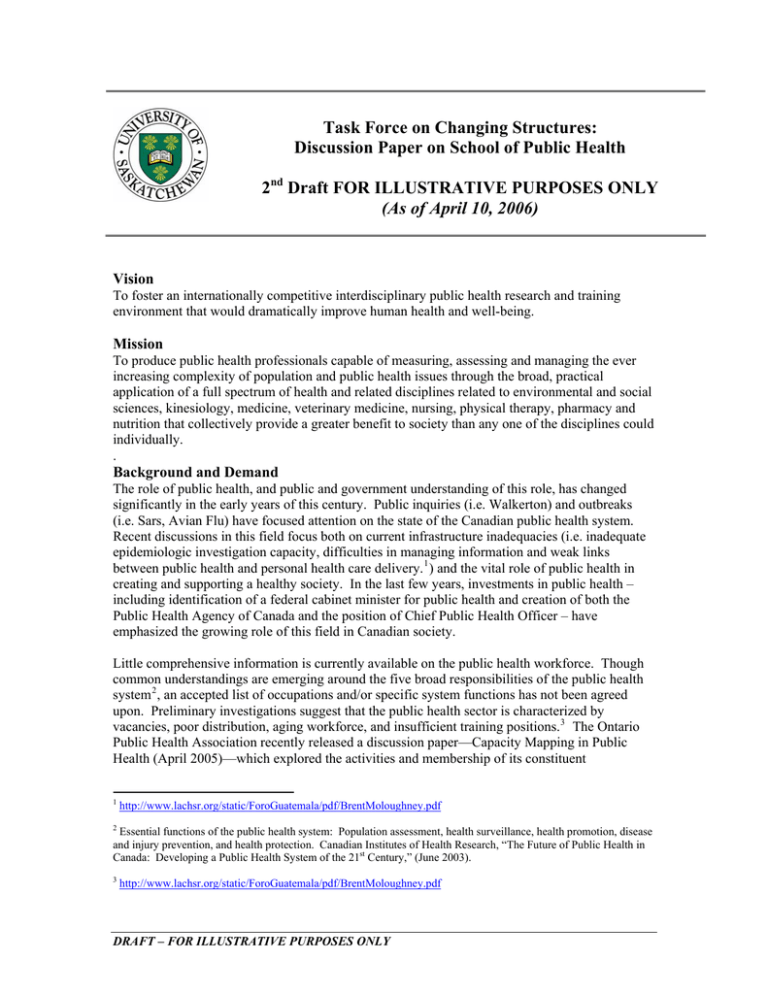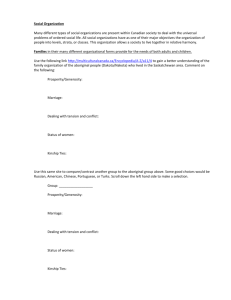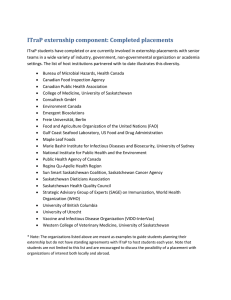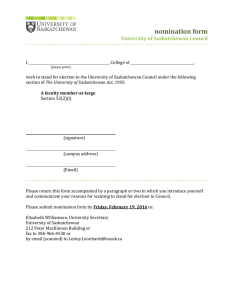Document 12184664
advertisement

Task Force on Changing Structures: Discussion Paper on School of Public Health 2nd Draft FOR ILLUSTRATIVE PURPOSES ONLY (As of April 10, 2006) Vision To foster an internationally competitive interdisciplinary public health research and training environment that would dramatically improve human health and well-being. Mission To produce public health professionals capable of measuring, assessing and managing the ever increasing complexity of population and public health issues through the broad, practical application of a full spectrum of health and related disciplines related to environmental and social sciences, kinesiology, medicine, veterinary medicine, nursing, physical therapy, pharmacy and nutrition that collectively provide a greater benefit to society than any one of the disciplines could individually. . Background and Demand The role of public health, and public and government understanding of this role, has changed significantly in the early years of this century. Public inquiries (i.e. Walkerton) and outbreaks (i.e. Sars, Avian Flu) have focused attention on the state of the Canadian public health system. Recent discussions in this field focus both on current infrastructure inadequacies (i.e. inadequate epidemiologic investigation capacity, difficulties in managing information and weak links between public health and personal health care delivery. 1 ) and the vital role of public health in creating and supporting a healthy society. In the last few years, investments in public health – including identification of a federal cabinet minister for public health and creation of both the Public Health Agency of Canada and the position of Chief Public Health Officer – have emphasized the growing role of this field in Canadian society. Little comprehensive information is currently available on the public health workforce. Though common understandings are emerging around the five broad responsibilities of the public health system 2 , an accepted list of occupations and/or specific system functions has not been agreed upon. Preliminary investigations suggest that the public health sector is characterized by vacancies, poor distribution, aging workforce, and insufficient training positions. 3 The Ontario Public Health Association recently released a discussion paper—Capacity Mapping in Public Health (April 2005)—which explored the activities and membership of its constituent 1 http://www.lachsr.org/static/ForoGuatemala/pdf/BrentMoloughney.pdf 2 Essential functions of the public health system: Population assessment, health surveillance, health promotion, disease and injury prevention, and health protection. Canadian Institutes of Health Research, “The Future of Public Health in Canada: Developing a Public Health System of the 21st Century,” (June 2003). 3 http://www.lachsr.org/static/ForoGuatemala/pdf/BrentMoloughney.pdf DRAFT – FOR ILLUSTRATIVE PURPOSES ONLY 2nd Draft FOR ILLLUSTRATIVE PURPOSES ONLY – Task Force on Changing Structures Discussion Paper on School of Public Health 2 associations. 4 More significantly the Public Health Agency of Canada has indicated that it is developing strategies to capture public health workforce information. 5 Significant to understanding the demand for graduate programs in public health is the recent work of the joint Task Group on Public Health Human Resources; this group is developing a set of core competencies for public health workers. These competencies emphasis: analysis and assessment, research and critical thinking, effective communication and leadership. A survey of Canadian universities indicates a scattering of undergraduate and graduate programs in public health. Highlights of current Canadian public health offerings include: In 1997, the University of Toronto entered its “Third Generation” of public health education through the establishment of a new Department of Public Health. The Department includes 200 plus faculty with either primary or cross-appointments in the Department. In conjunction with the Graduate Department of Public Health, the Department boasted 300 graduate students in its four MSc/PhD programs (Behavioural Science, Biostatistics, Epidemiology, Occupations and Environmental Health) and five professional MHSc programs (Community Health & Epidemiology, Health Promotion, Occupational & Environmental Health, Community Nutrition, and Family & Community Medicine). Lakehead University introduced a Masters of Public Health in 2002. The program is specifically geared to issue of public health in northern, rural and remote communities and provides two options for study – health studies or a nursing specialization. In 2005, Simon Fraser University identified a unique niche in the public health sector and introduced a Masters in Global Health to complement its existing Masters in Population and Public Health. Billed as one of the first University’s to offer this focus, the M.A. in Global Health is intended to develop expertise and in public policy development that is informed by global health issues and is culturally sensitive. Programs and Students The School would offer a range of graduate training programs. A course-based Masters degree in Public Health (MPH) would be the foundational program. Built around that program would be a thesis-based Masters degree in Public Health (MSc), and a thesis-based Doctoral degree in Public Health (DrPH). Strength in vaccine-preventable infectious diseases would be present in Masters and Doctoral degrees in Vaccinology. Programs that would transfer over from the College of Medicine include the Masters and Doctoral degrees in Community Health and Epidemiology, with future specializations in epidemiology and biostatistics. This would represent approximately 4 Ontario Public Health Association recently released a discussion paper - Capacity Mapping in Public Health (April 2005). http://www.opha.on.ca/resources/CapacityMapping-FinalReport-2005.pdf 5 More specific information is available through the Canadian Institute of Health Information. This agency maintains a health database on aggregate, supply-based information on the number of health care personnel in Canada and in 2004 launched a project to expand collection to five regulated health professions. The Health Database contains aggregate, supply-based information on the number of health care personnel in Canada, for selected occupations, by province/territory and year. Health professions included are : chiropractors, dental hygienists, dentists, dietitians, health records professionals, health service executives, licensed practical nurses, medical laboratory technologists, medical radiation technologists, medical physicists, midwives, occupational therapists, optometrists, pharmacists, physicians, physiotherapists, psychologists, registered nurses, registered psychiatric nurses, respiratory therapists and social workers. Human Health Resources, Canadian Institute of Health Information http://secure.cihi.ca/cihiweb/dispPage.jsp?cw_page=hhrdata_e DRAFT – FOR ILLUSTRATIVE PURPOSES ONLY 2nd Draft FOR ILLLUSTRATIVE PURPOSES ONLY – Task Force on Changing Structures Discussion Paper on School of Public Health 3 110 students (20 MPH, 15 MSc, 15 DrPH, 10 MSc Vaccinology, 10 PhD Vaccinology, 30 MSc CH&E, 10 PhD CH&E). Post-doctoral fellows in the School may number 20. Graduate students would enter the School’s programs with undergraduate backgrounds in the professional health sciences (70%), basic sciences (10%), social sciences (10%), and management and administration (10%). Depending of their field, they would find employment as leaders, managers, and researchers in public health departments, health regions, ministries of health, the food, livestock, pharmaceutical industries, and academic institutions. Public health issues have been at the forefront of concerns for the government and citizens of Canada in recent years. The outbreaks of SARS, avian influenza and contaminated water in Walkerton and North Battleford have been attributed in national commissions of inquiry to inadequate public health infrastructure. Among the urgent issues that need to be addressed, the Naylor and Kirby commissions identified inadequate public health human resources and training, insufficient investment in public health research and knowledge application. The Public Health Agency of Canada and the post of Chief Public Health Officer have been created and are leading the rapidly advancing developments in these areas. A School of Public Health at the University of Saskatchewan is well-placed to play a key role in this national agenda. Specific Research Units A number of existing research units at the University of Saskatchewan might productively be housed together in a School of Public Health. These include the Vaccine and Infectious Disease Organization (VIDO), Canadian Centre for Health and Safety in Agriculture (CCHSA), Saskatchewan Population Health and Evaluation Research Unit (SPHERU), CommunityUniversity Institute for Social Research (CUISR), Indigenous Peoples’ Health Research Centre (IPHRC), the Prairie Region Health Promotion Research Centre (PRHPRC) and the sociopopulation health research group of the College of Kinesiology. Such co-location would be expected to provide excellent opportunity for creative synergy between research teams and paradigms. The University of Saskatchewan is uniquely placed to be a national and international centre of excellence for public health research and teaching. It has now, or has the ability to attain, preeminence in 1.) vaccinology and infectious disease epidemiology, 2.) rural and remote public health, 3.) veterinary public health, 4.) aboriginal peoples’ public health, 5.) socio-population health. Interdisciplinary collaboration is well developed at the University, but the creation of a School of Public Health will raise it to a new level. The School will serve as a crucible for the discovery, application and dissemination of new knowledge in public health. Faculty and trainees will be well positioned to respond quickly to the complex health issues of the 21st century, which frequently cross disciplinary boundaries, be this a response to a call for research or a public health emergency. Faculty and Staff In the short term, we envisage a number of new and existing positions to be drawn together to form the school, to meet the demand in the realms of teaching and research, and to be eligible for accreditation with the North American accrediting body (the Council for Education in Public Health). We anticipate a number of new faculty positions, including an Executive Director responsible for the overall leadership of the school; a number of existing faculty positions drawn from appropriate/cognate/contributing disciplines (Community Health and Epidemiology, CCHSA from Medicine; WCVM; Nursing; Kinesiology; Health Care Administration from Commerce); a number of ‘joint’ appointments from existing departmental faculty; a number of ‘adjunct’ appointments from co-located partners, some support staff to provide technical, DRAFT – FOR ILLUSTRATIVE PURPOSES ONLY 2nd Draft FOR ILLLUSTRATIVE PURPOSES ONLY – Task Force on Changing Structures Discussion Paper on School of Public Health 4 administrative, and secretarial support; affiliation with existing Canada Research Chairs; affiliation with principal investigators currently associated with VIDO including staff and trainees; a number of endowed chairs including the creation of a new University of Saskatchewan Centennial Chair position from the University’s capital campaign. Space The School of Public Health will be located in the Socio-Population Health building of the new Academic Health Science Complex and have associated facilities, including labs, in other Colleges. It is currently envisaged that VIDO may become part of the School of Public Health (initial discussions). If this comes to fruition, significant space would become available to the School of Public Health. VIDO currently has over 100,000 sq. ft. of laboratory and office space, plus lecture rooms and is adding 120,000 sq.ft. of new level III laboratories and animal facilities to accommodate work on emerging diseases. The combined existing and new space will accommodate between 6-10 new faculty recruits as proposed in the “Academic Opportunities for Infectious Diseases” at the University of Saskatchewan. Structure and Governance The School of Public Health is best positioned in the university as an academic entity equivalent to, but separate from, the professional health science colleges. This would not only promote the necessary interdisciplinary research and teaching environment, but is required for accreditation by the North American accrediting body, the Council on Education for Public Health (www.ceph.org). Appointments of new faculty and transfers will be to the School; others will be joint appointments subject to the arrangements with existing departments and colleges. The Director of the School will report to the Provost and sit on the Council of Health Science Deans. The School will be an interdisciplinary unit with its own collegial processes (annual assessment, tenure and promotion) and some activities managed through direct relationships to senior administration and Council (e.g., curriculum). Objectives and Accountabilities The School is a new initiative to be launched in 2006 that will be measured in 2011 against the following ten objectives: 1. To promote a university-wide and societal awareness of the focus on public health and well-being. 2. To produce an interdisciplinary transformation of training in the health science colleges 3. 4. 5. 6. 7. 8. and College of Arts and Science without necessarily diminishing disciplinary expertise residing within departments and colleges. To develop strong linkages between health science, infectious disease science and veterinary science leading to unique research and programmatic opportunities. Create interdisciplinary visibility and focus; show how interdisciplinary works! To increase graduate student enrolment to a total of 110 students. To increase overall public health research (e.g. grants and contracts) by 50%. Establish the U of S as the one of the top world Centres for Public Health research and learning (as measured by external reputation surveys). Establish linkages (national and international) with researchers and organizations that would enhance the profile of the University of Saskatchewan and recruitment opportunities. DRAFT – FOR ILLUSTRATIVE PURPOSES ONLY 2nd Draft FOR ILLLUSTRATIVE PURPOSES ONLY – Task Force on Changing Structures Discussion Paper on School of Public Health 5 Outreach – Opportunities for Leverage The School of Public Health will work closely with provincial and Canadian partners in developing its programs. These partners include: the Saskatoon Health Region; Saskatchewan Health; Medical Officers Council of Saskatchewan; Canadian Food Inspection Agency; Vaccine and Infectious Disease Organization; Toxicology Research Centre; Centre for Coastal Health, Nanaimo, and the Public Health Agency of Canada. Partnerships with the Universities of Alberta, Manitoba and Northern British Columbia are being explored. Through these interactions the School will: 1. Become a node of The Public Health Agency of Canada’s National Coordinating Centres in Infectious Diseases, Socio-population Health, and Aboriginal Peoples’ Health. 2. Be a critical player in Canada’s vaccine research infrastructure. 3. Be the anchor for the Canadian Centre for Health and Safety in Agriculture. 4. Investigate significant health issues of aboriginal populations. DRAFT – FOR ILLUSTRATIVE PURPOSES ONLY





